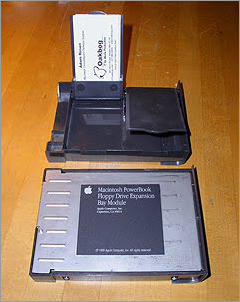 Greetings and Happy Holidaze from Boston! A few recent donations to the Mac Museum got me musing about unusual bits of PowerBook Esoterica, and how good ideas are often repeated but skip product generations.
Greetings and Happy Holidaze from Boston! A few recent donations to the Mac Museum got me musing about unusual bits of PowerBook Esoterica, and how good ideas are often repeated but skip product generations.
A colleague of mine recently donated a PowerBook 3400c and assorted box of Mac items to me, which I was happy to give a good home. The 3400c was the top of the line PowerBook in the pre-G3 era, and vendors really took advantage of it’s ability to add capability via expansion bays. A CD-ROM drive, spare batteries, floppy drive and Zip drive modules were common on this series, and the expansion bay design survived across the G3 Wallstreet, Lombard and Pismo models.
However one thing I’d never seen before was this unique module, which mimics the floppy disk module but is (apparently) meant to store business cards or other similarly sized items in your laptop! The donator didn’t know the history of this computer, so we don’t know who made this acccessory or how popular it was. Definitely a better use of space than the PowerBook G3 (Pismo) Weight Saving device – essentially a hollow battery case that nobody ever used – but I still would have used a Zip module myself.
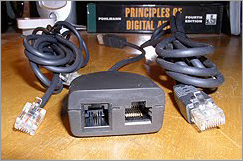 The 3400c wasn’t done with it’s surprises yet. Among the pile of cables in the box was a combination RJ45 ethernet jack and RJ11 phone jack, which used an RJ45 jack to connect to the computer. While ethernet ports and modems are both communications devices, it’s rare to see them combined in this fashion. It saves about a half inch of space on the back of the laptop but instead creates a new, custom adapter. Sometimes the way Apple thinks is, well, Just Different. But I do appreciate the matching dark grey ethernet and phone cables which were included – a classy touch!
The 3400c wasn’t done with it’s surprises yet. Among the pile of cables in the box was a combination RJ45 ethernet jack and RJ11 phone jack, which used an RJ45 jack to connect to the computer. While ethernet ports and modems are both communications devices, it’s rare to see them combined in this fashion. It saves about a half inch of space on the back of the laptop but instead creates a new, custom adapter. Sometimes the way Apple thinks is, well, Just Different. But I do appreciate the matching dark grey ethernet and phone cables which were included – a classy touch!
A few weeks later the Museum was given a PowerBook Duo 230c along with a box containing the dock and many accessories. The Duo was Apple’s first sub-notebook sized computer, similar to the 2400c and 12″ iBook/PowerBook G4. The computer just has the CPU, keyboard and screen, and used a dock (full or mini) to connect to monitors and other peripherals. The Duo hit a niche for many PowerBook users and was a popular model during the 68k and PowerPC eras. I’ve always preferred fully functional integrated laptops for my own use, so I wasn’t very familiar with this series.
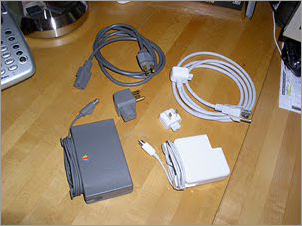 Besides the elegant engineering of the dock itself, what really caught my attention was the design of the AC adapter. The transformer (power brick) has an AC port which can be used interchangeably with a long AC cord or a short AC plug to vary the overall length; it also contained a pair of fold out flaps around which to wind the thin DC power cord which plugged directly into the computer. Look familiar? Other than the color difference and some small design changes, it’s not much different than the AC adapter introduced with the iBook/PowerBook G4 and used to this day!
Besides the elegant engineering of the dock itself, what really caught my attention was the design of the AC adapter. The transformer (power brick) has an AC port which can be used interchangeably with a long AC cord or a short AC plug to vary the overall length; it also contained a pair of fold out flaps around which to wind the thin DC power cord which plugged directly into the computer. Look familiar? Other than the color difference and some small design changes, it’s not much different than the AC adapter introduced with the iBook/PowerBook G4 and used to this day!
Plus ça change, plus c’est la même chose.
A warm thanks to Andy Espo of Natick, MA for the PowerBook 3400c, and to John Chapin of Cambridge, MA for the PowerBook Duo 230c. Your generosity is appreciated.
The Cult of Mac bows to you, and sacrifices a new PC running Windows 7 in your honor…
Posted on December 27th, 2009 in
Vintage Mac Museum Blog |
1 Comment »
Haven’t had a lot of time recently to attend to VMM tasks, dealing with issues on other fronts: home repairs, car repairs, Thanksgiving weekend, and (fortunately) a busy consulting schedule. Just a few vintage odds and ends between other projects.
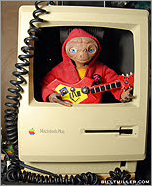 I have enough classic Macs now (512k/Plus/SE variants) that when I get new ones I tear them down for useable parts – logic board, power supply, screens, etc.. Once emptied the iconic Macintosh case remains. If its in good condition I clean things up, reassemble the shell and pass them on to folks who might enjoy them. Gave one recently to my friend Bill T Miller, who send me this great picture of ET jamming in his new Mac TV Studio!
I have enough classic Macs now (512k/Plus/SE variants) that when I get new ones I tear them down for useable parts – logic board, power supply, screens, etc.. Once emptied the iconic Macintosh case remains. If its in good condition I clean things up, reassemble the shell and pass them on to folks who might enjoy them. Gave one recently to my friend Bill T Miller, who send me this great picture of ET jamming in his new Mac TV Studio!
For those following the Lisa Saga, we last left our protagonist in the Valley of Unrecognized Keyboards. Since then some contact cleaner and a vigorous cleaning of the cable plug and Lisa jacks seems to have fixed the missing keyboard error at startup. Alas, I still can’t get the keyboard to do anything. My suspicion is the Apple Key is dead or has worn foam, and hence I can’t press APPLE-2 or APPLE-3 when prompted.
In order to proceed further without having a second keyboard, I need to boot the Lisa off a MacWorks floppy disk (the Mac Plus emulator for Lisa), then try the Notepad program to see if any keys work. This requires a working 400k floppy drive, which my Lisas don’t have. In fact I have a box full of frozen similar drives from old Macs, slowly growing over several years. 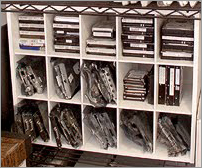 It’s a common problem with old floppy drives. Frankly I’ve just been too unmotivated to disassemble and re-lubricate them – last weekend, raking leaves seemed preferable! I’ll probably pull a working drive from a 512k sometime and swap that in, I can get those apart pretty quicky.
It’s a common problem with old floppy drives. Frankly I’ve just been too unmotivated to disassemble and re-lubricate them – last weekend, raking leaves seemed preferable! I’ll probably pull a working drive from a 512k sometime and swap that in, I can get those apart pretty quicky.
Meanwhile, I did find some time to finish organizing spare parts in the “VMM Back Room” (storage closet). There are now lots of nice labelled boxes for different models of Macs. Also found that a closet shoe rack makes a great organizer for expansion cards and old hard drives, much better than the big plastic recycling bin I was using earlier. Old NuBus cards never die, they just get dustier and multiply in dark closets…
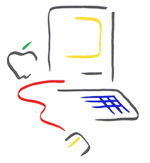 With most Mac collectors the beginning of one’s collection is usually a rather random event. We have either been given or somehow acquired an old Macintosh, or decided to pickup a piece of our computing past. One model becomes two, then four, and soon the first space constraints emerge. Another Mac Collection is born.
With most Mac collectors the beginning of one’s collection is usually a rather random event. We have either been given or somehow acquired an old Macintosh, or decided to pickup a piece of our computing past. One model becomes two, then four, and soon the first space constraints emerge. Another Mac Collection is born.
My own Vintage Mac Museum (Boston, MA, US) had such roots, beginning in 2001 with the launch of Mac OS X. An old Mac Plus picked up at a flea market became a small circle of classic Macs, then a dozen 68k machines. Along the way, other collectors found me. Here are some fellow Cult of Mac members and their collections whom I’ve heard from or discovered in my travels:
Macca (Northwest Florida, US)
A comprehensive shrine to all things Apple from James Savage, co-host of the RetroMacCast. Many rare items and a great use of space. Bow to Macca…
A Little Byte Different (San Francisco, CA, US)
Henry “Hap” Plain’s incredible collection of transparent Macs and rare Apple prototypes. As he says, a little byte different. Mere mortals lust after this stuff.
Apple Computer Collection (The Phillipines)
Philippe Poppe has assembled an impressive collection of Macs both common and rare, complemented by a beautiful website showing off the details.
Jim’s Prototype Collection (Portland, OR, US)
James Abeles shares his amazing assemblage of unreleased Apple prototypes – transparent units, mockups, and concepts which never saw the light of day. You don’t often find these gems on eBay…
a personal collection of all things Apple (UK)
“The collection started with a discarded early Mac Plus … In a few minutes had a fully functioning example of why Apple Computer gave the masses an opportunity to join the digital revolution.”
tam – The Apple Museum (Newton, MA, US)
Another private basement collection, a sweet little space with lots of gear and old Mac/Apple resources.
Alex’s Apple Orchard (Maine, US)
Alex and his family have assembled one of the largest Apple collections around. Great presentation and expanse.
—–
This page will be updated periodically with new collections, as I learn of more efforts. If you are a Mac Collector with an online presence, please contact me or leave a link to your site in the comments.
Posted on November 19th, 2009 in
Vintage Mac Museum Blog |
3 Comments »
A nice reminder this week of the value of old Macs, and a bit of crossover between Current and Vintage Macintosh computing. Always an enjoyable Low End Mac experience!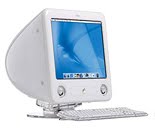
I recently acquired several old Macs while working with a client, one of which was an eMac. The eMac is a very capable G4-based system, the descendent of the G3 iMac. Originally designed for the education market (hence e-Mac), it was a good price/value configuration for under $1000 and Apple sold millions to consumers.
Compared to the iMac it’s a rather subdued design, and heavy with a built-in 17″ CRT monitor, but it’s built to withstand abuse. This specific eMac had the tilt/swivel base option, which is quite practical and substantially improves the visual aesthetic of the system. We Mac nerds care about such things…
I reformatted the drive and installed Mac OS X 10.4 “Tiger” along with OS 9 for Classic and iLife ’06. This combination runs very nicely on a G4 and provides compatibility with a wide range of old and new Mac software – run Classic apps side-by-side with modern versions of Mail, Safari and Firefox.
At about the same time, another client asked if I had any old Macs available for an associate who needed a functional computer for her family’s use. Basically just internet and word processing, but she had a limited budget. eMac to the rescue!
We got in touch, and I offered to sell the computer for $100. She asked “why so cheap?” I said that’s about what they’re worth, and I’m just happy to see it go to a good home. Turns out video editing is one of her hobbies, so having a copy of iMovie and iWeb (along with FireWire ports) was very welcome. A 1GHz G4 running iMovie HD (version 6) is nothing to sneeze at, lots of good work has been (and will be) done on such a platform.
She stopped by one morning this week to pickup the computer. The next day I got this email:
Thanks for the eMac. I am in love with it. I have an external hard drive with video footage on it I forgot about so I will be having fun soon editing.
What one person has outgrown, now provides options for somebody else. There is room at all levels in the marketplace for Macs of all ages. A toast in praise of the $100 computer!
Posted on November 6th, 2009 in
Vintage Mac Museum Blog |
1 Comment »
Several months ago I mentioned that a pair of Apple Lisa computers were donated to the Vintage Mac Museum (see Lisa Joins the Family and Why We Collect). The Lisa is a seminal item, both in general computing and Apple Macintosh history, and I’m lucky to have a pair that even partially work.
The resurrecting experience to date has been most challenging, and has only just begun.
The First Challenge – Finding a Keyboard
My two Lisas were provided without mice or keyboards. Missing mice aren’t a big problem, the Lisa uses the same DB-9 connector as the early Macs so an original Macintosh, 512k or Mac Plus mouse will work. The keyboard is another story, it’s completely proprietary (actually rather stylish, for its day) with custom electronics and a 1/4″ phone connector. There are currently no substitutes.
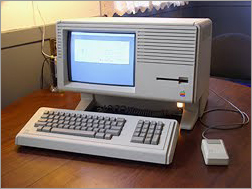 I quickly learned they were hard to find. And in a case of “you are always your own worst enemy” (another hobby of mine), during my search I managed to get into an, err, emotional exchange with the one guy on eBay who deals in these things, thus earning each other’s mutual dislike and thwarting me in my task even further. Good way to proceed…
I quickly learned they were hard to find. And in a case of “you are always your own worst enemy” (another hobby of mine), during my search I managed to get into an, err, emotional exchange with the one guy on eBay who deals in these things, thus earning each other’s mutual dislike and thwarting me in my task even further. Good way to proceed…
Fortunately the Lisa community as a whole is sharing and generous, and after some time I managed to connect with somebody who had a spare keyboard available. All the way from Germany to the USA, a big thanks to Tom Sharpf from Bavaria (home of the original Oktoberfest!) for making a keyboard available and dealing with an international exchange.
It looks great in the kitchen with the now complete system, ehh?
The Second Challenge – Using That Keyboard
So after a 4 month delay, I haul out my two Lisas (not an easy task, they weigh 48 pounds each), connect the keyboard and fire one up. This is a slow process – maybe “warming up the car’s engine” would be a better analogy. It can take about a minute from pushing the power button until the hardware self tests are completed.
Then I see the missing keyboard icon again:
 What? I just connected a keyboard! The icon disappeared, and after another several minutes trying to find a bootable ProFile hard disk (which I know isn’t working yet) the Lisa asks for a floppy disk. I shut off the system and try again. No missing keyboard icon the second time, but when I get to the floppy boot screen and try out the command key options presented (APPLE-2 and APPLE-3), nothing happens. Reboot again. Missing keyboard icon. Sigh…
What? I just connected a keyboard! The icon disappeared, and after another several minutes trying to find a bootable ProFile hard disk (which I know isn’t working yet) the Lisa asks for a floppy disk. I shut off the system and try again. No missing keyboard icon the second time, but when I get to the floppy boot screen and try out the command key options presented (APPLE-2 and APPLE-3), nothing happens. Reboot again. Missing keyboard icon. Sigh…
I know Tom tested the keyboard before shipping it out and it worked fine.
I hookup the second Lisa, same thing. Keyboard is not recognized. I clean off the plug, try inserting/removing it a few times, reboot repeatedly. Nope. Try the first system again. Nope. Meanwhile you really should hear the sound of 30 year old hard drives spinning up and trying to come to life, it’s a peaceful and soothing noise most suitable to calming one’s nerves as they repeatedly attempt a failing task.
AAARRRGGGHHHHHH! I’m finding that a Lisa can be like an ailing older family member: someone you love and respect, but as they age the relationship can get stressful. They get Fragile. (Even, perhaps, Cranky :) I have to remind myself that I like working with vintage computers!
I asked for some help, and the incredibly knowledgeable Ray Arachelian (author of LisaEm, the definitive Lisa Emulator) offered some suggestions. If I’m lucky some contact cleaner on the jack and connectors might help, otherwise I will need to do some electrical testing on the cable and contacts. I will be mucking around with this over the next few days.
I may be drinking some at the time, too.
Once that’s done I can get to work re-lubricating the 400k floppies and trying to get the ProFile hard drives recognized so that I can reinstall the Lisa OS. My Macs are anxiously awaiting a chance to talk with their Great Great Grandmother.
To be continued…
Posted on October 30th, 2009 in
Vintage Mac Museum Blog |
1 Comment »
I recently learned of a hidden capability of the Apple Installer application, namely the ability to display the installation log in real-time. While the Installer is running, choose Window –> Installer Log or type Command-L (aka Apple-L). If you then choose “Show Errors & All Progress” from the log window’s popup menu, you’ll be able to view what’s happening while the wait cursor spins.
I suppose this isn’t so much hidden as unpublicized, but few people seem aware of this capability. During long installations such as Mac OS X installs or upgrades, it helps to see the log being updated to know that your computer is actually still doing something and hasn’t crashed.
During a recent Leopard upgrade – hmmm, is this now a Vintage Mac OS? – I enabled the log viewer and noticed a few odd things scrolling by. I decided to save the log when installation was complete, and parsed out some interesting lines after the fact:
Oct 15 18:12:16 localhost LCA[65]: Launching the Installer using language code “English”
The start of the process
Oct 15 18:12:41 localhost OSInstaller[155]: CPSGetProcessInfo(): This call is deprecated and should not be called anymore.
Oct 15 18:12:41 localhost OSInstaller[155]: CPSPBGetProcessInfo(): This call is deprecated and should not be called anymore.
If these calls are deprecated, why is the Apple Installer still calling them?
Oct 15 18:15:26 localhost OSInstaller[155]: Processing BaseSystem:
Oct 15 18:15:26 localhost OSInstaller[155]: Determining files to install
Oct 15 18:15:27 localhost OSInstaller[155]: It took 1.34 seconds to create the install plan for BaseSystem.
Oct 15 18:15:27 localhost OSInstaller[155]: Configuring deferred files
Much faster than I could create the install plan, that’s for sure; what happens to the deferred files?
Oct 15 18:44:36 localhost root[721]: Begin script: RemoveClientLicense.sh
Oct 15 18:44:36 localhost root[723]: End script: RemoveClientLicense.sh
Interesting; Mac OS X Server is licensed. Perhaps the “honor system” policy Apple uses with Mac OS X Client may not always be so trusting?
Oct 15 18:46:41 localhost OSInstaller[155]: **** Summary Information ****
Oct 15 18:46:41 localhost OSInstaller[155]: Operation Elapsed time
Oct 15 18:46:41 localhost OSInstaller[155]: script 210.33 seconds
Oct 15 18:46:41 localhost OSInstaller[155]: zero 0.03 seconds
Oct 15 18:46:41 localhost OSInstaller[155]: install 1849.14 seconds
Oct 15 18:46:41 localhost OSInstaller[155]: validate 761.56 seconds
Oct 15 18:46:41 localhost OSInstaller[155]: os 2.23 seconds
Oct 15 18:46:41 localhost OSInstaller[155]: extract 829.08 seconds
Oct 15 18:46:41 localhost OSInstaller[155]: receipt 3.65 seconds
Oct 15 18:46:41 localhost OSInstaller[155]: disk 25.50 seconds
Oct 15 18:46:41 localhost OSInstaller[155]: config 44.41 seconds
Oct 15 18:46:41 localhost OSInstaller[155]: Finalizing installation.
Hmmm, this elapsed time totals out to 3725.93 seconds, or 62.1 minutes. According to the log entries, actual elapsed time is about 34.5 minutes. No wonder those “remaining time” calculations are always so far off…
Oct 15 18:46:56 localhost OSInstaller[155]: installAutoFSMonitor: open failed
The final word in the OS X install log is failed. That doesn’t inspire confidence. Perhaps it’s the Revenge of the Deferred Files!
 Greetings and Happy Holidaze from Boston! A few recent donations to the Mac Museum got me musing about unusual bits of PowerBook Esoterica, and how good ideas are often repeated but skip product generations.
Greetings and Happy Holidaze from Boston! A few recent donations to the Mac Museum got me musing about unusual bits of PowerBook Esoterica, and how good ideas are often repeated but skip product generations. The 3400c wasn’t done with it’s surprises yet. Among the pile of cables in the box was a combination RJ45 ethernet jack and RJ11 phone jack, which used an RJ45 jack to connect to the computer. While ethernet ports and modems are both communications devices, it’s rare to see them combined in this fashion. It saves about a half inch of space on the back of the laptop but instead creates a new, custom adapter. Sometimes the way Apple thinks is, well, Just Different. But I do appreciate the matching dark grey ethernet and phone cables which were included – a classy touch!
The 3400c wasn’t done with it’s surprises yet. Among the pile of cables in the box was a combination RJ45 ethernet jack and RJ11 phone jack, which used an RJ45 jack to connect to the computer. While ethernet ports and modems are both communications devices, it’s rare to see them combined in this fashion. It saves about a half inch of space on the back of the laptop but instead creates a new, custom adapter. Sometimes the way Apple thinks is, well, Just Different. But I do appreciate the matching dark grey ethernet and phone cables which were included – a classy touch! Besides the elegant engineering of the dock itself, what really caught my attention was the design of the AC adapter. The transformer (power brick) has an AC port which can be used interchangeably with a long AC cord or a short AC plug to vary the overall length; it also contained a pair of fold out flaps around which to wind the thin DC power cord which plugged directly into the computer. Look familiar? Other than the color difference and some small design changes, it’s not much different than the AC adapter introduced with the iBook/PowerBook G4 and used to this day!
Besides the elegant engineering of the dock itself, what really caught my attention was the design of the AC adapter. The transformer (power brick) has an AC port which can be used interchangeably with a long AC cord or a short AC plug to vary the overall length; it also contained a pair of fold out flaps around which to wind the thin DC power cord which plugged directly into the computer. Look familiar? Other than the color difference and some small design changes, it’s not much different than the AC adapter introduced with the iBook/PowerBook G4 and used to this day!
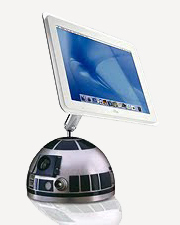
 I have enough classic Macs now (512k/Plus/SE variants) that when I get new ones I tear them down for useable parts – logic board, power supply, screens,
I have enough classic Macs now (512k/Plus/SE variants) that when I get new ones I tear them down for useable parts – logic board, power supply, screens,  It’s a common problem with old floppy drives. Frankly I’ve just been too unmotivated to disassemble and re-lubricate them – last weekend, raking leaves seemed preferable! I’ll probably pull a working drive from a 512k sometime and swap that in, I can get those apart pretty quicky.
It’s a common problem with old floppy drives. Frankly I’ve just been too unmotivated to disassemble and re-lubricate them – last weekend, raking leaves seemed preferable! I’ll probably pull a working drive from a 512k sometime and swap that in, I can get those apart pretty quicky. With most Mac collectors the beginning of one’s collection is usually a rather random event. We have either been given or somehow acquired an old Macintosh, or decided to pickup a piece of our computing past. One model becomes two, then four, and soon the first space constraints emerge. Another Mac Collection is born.
With most Mac collectors the beginning of one’s collection is usually a rather random event. We have either been given or somehow acquired an old Macintosh, or decided to pickup a piece of our computing past. One model becomes two, then four, and soon the first space constraints emerge. Another Mac Collection is born.
 I quickly learned they were hard to find. And in a case of “you are always your own worst enemy” (another hobby of mine), during my search I managed to get into an, err, emotional exchange with the
I quickly learned they were hard to find. And in a case of “you are always your own worst enemy” (another hobby of mine), during my search I managed to get into an, err, emotional exchange with the  What? I just connected a keyboard! The icon disappeared, and after another several minutes trying to find a bootable ProFile hard disk (which I know isn’t working yet) the Lisa asks for a floppy disk. I shut off the system and try again. No missing keyboard icon the second time, but when I get to the floppy boot screen and try out the command key options presented (APPLE-2 and APPLE-3), nothing happens. Reboot again. Missing keyboard icon. Sigh…
What? I just connected a keyboard! The icon disappeared, and after another several minutes trying to find a bootable ProFile hard disk (which I know isn’t working yet) the Lisa asks for a floppy disk. I shut off the system and try again. No missing keyboard icon the second time, but when I get to the floppy boot screen and try out the command key options presented (APPLE-2 and APPLE-3), nothing happens. Reboot again. Missing keyboard icon. Sigh…